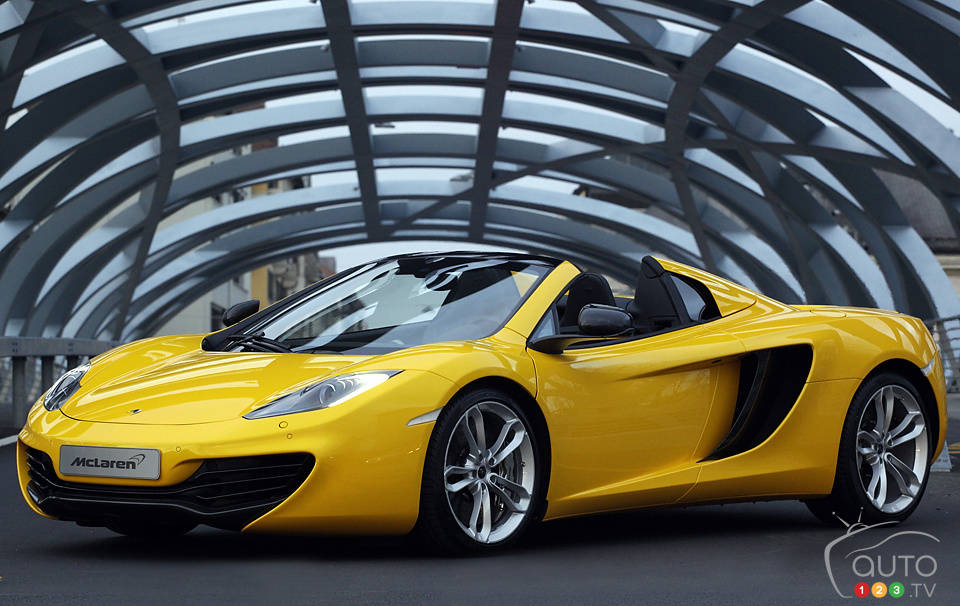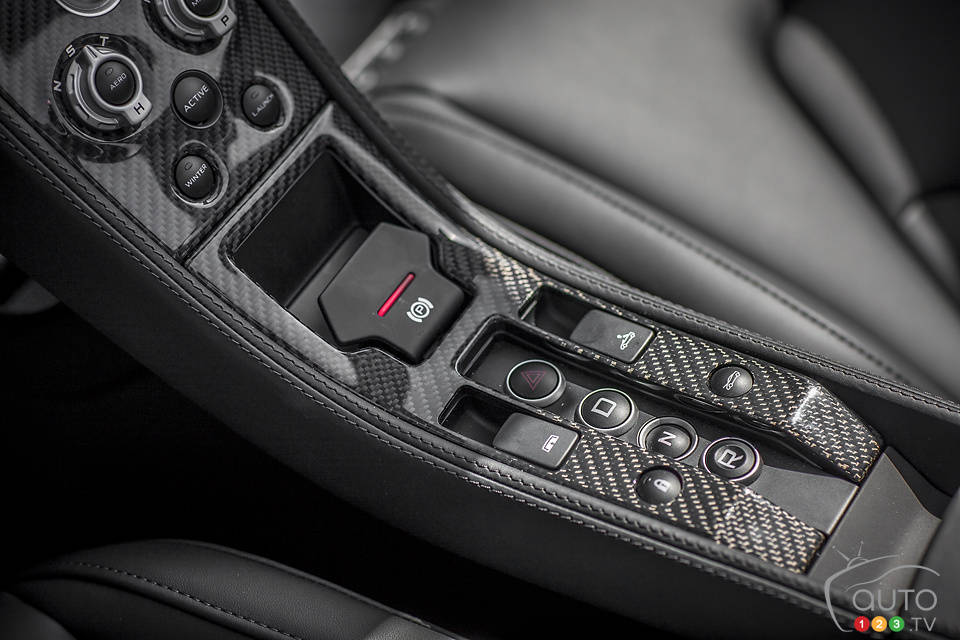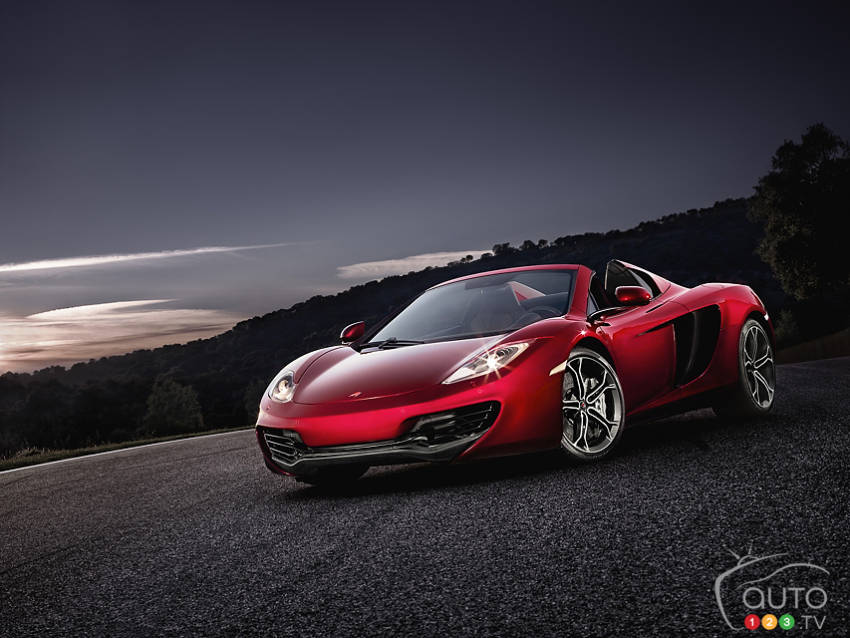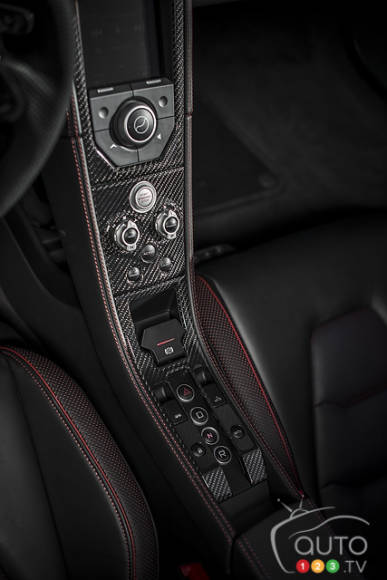What is the 2013 McLaren MP4-12C/Spider?
It is difficult to decide where to start when it comes to explaining how incredible the McLaren MP4-12C is.
McLaren, the fabled British firm, gained prominence when they unleashed their legendary F1 road car. Their latest road car, the MP4-12C, created a stir in the supercar segment providing serious competition to the likes of Ferrari and Lamborghini.
Carbon Fibre MonoCell
The MP4-12C’s carbon fibre “MonoCell” makes it rare among sports cars costing less than half a million dollars. McLaren is a pioneer in carbon-fibre-based racecars and road cars. Remember, McLaren built the carbon structure for the previous Mercedes-Benz SLR; a process that took about 400 hours per car.
In contrast, the MP4-12C is built via a game-changing “resin transfer” process. To create the MP4-12C tub, two carbon-fibre sheets are laid out in a special tool. The tool is then closed and the resin is injected under pressure for 15 minutes. After that the tool is baked for four hours, and then, voila! You have a complete, one-piece, carbon-fibre tub all ready to go.
Lots of Aluminum, too
Unlike the F1, the MP4-12C only uses carbon fibre for the MonoCell, which essentially comprises the centre structure of the vehicle. Aluminum substructures are bolted to the MonoCell, both up front and out back. These substructures make up the vehicle’s crumple zones, and make the MP4-12C a lot easier and less expensive to repair than a full-on carbon-fibre underbody.
This also makes the MP4-12C heavier than the F1, but heavy is a relative term -- the entire vehicle weighs only 2,866 lbs.
The front hood, roof, and front fenders (or “wings”) are also constructed of aluminum. The other panels are fiberglass (SMC).
2013 McLaren MP4-12C/Spider powertrain
The 3.8L 90-degree V8 is designed by McLaren and built by a supplier in England. It features all-aluminum construction, dry sump, direct injection, and twin turbos. It produces 616 hp at 7,000 rpm and 442 lb-ft of torque at 6,500 rpm.
Eighty percent of that torque is available at 2,000 rpm and 100% at 3,000 rpm. This should make for lively performance; the McLaren covers the 0-60 mph in 3 seconds and has a top speed over 205 mph. Retail pricing starts at $250,000.
The stainless steel exhaust is mounted high on the engine to facilitate a short and direct exit strategy -- straight out with no kinks. There is also an optional alloy exhaust system.
The engine is mated to a 7-speed, double-clutch transmission. Manual shifting is possible via F1-style aluminum paddles that pivot with the steering wheel.
Interior and exterior of the 2013 McLaren MP4-12C/Spider
The McLaren MP4-12C does have cup holders and they are located under the console. The doors open, or rather, rise up at the touch of a button. There are no door handles.
A Spider drop-top version, which features a power-retractable hard top, is also available for a $30,000 supplement.
It’s along way down into the driver’s seat, and over a substantial carbon-fibre rail. McLaren said it went to great lengths to make sure the driver's seat, the steering wheel, and the pedals were perfectly in line. You sit only a few inches off the "floorboard" with your legs sticking straight out, not unlike a formula racecar.
The usual assortment of high-tech info and entertainment devices is present, though the focus is clearly on driving. Like the rest of the car, the inside of the McLaren MP4-12C is functional and purposeful. There are many options available, however, the most interesting might be the track-data display, courtesy of three onboard cameras and data acquisition capability.
It is difficult to decide where to start when it comes to explaining how incredible the McLaren MP4-12C is.
McLaren, the fabled British firm, gained prominence when they unleashed their legendary F1 road car. Their latest road car, the MP4-12C, created a stir in the supercar segment providing serious competition to the likes of Ferrari and Lamborghini.
 |
Carbon Fibre MonoCell
The MP4-12C’s carbon fibre “MonoCell” makes it rare among sports cars costing less than half a million dollars. McLaren is a pioneer in carbon-fibre-based racecars and road cars. Remember, McLaren built the carbon structure for the previous Mercedes-Benz SLR; a process that took about 400 hours per car.
In contrast, the MP4-12C is built via a game-changing “resin transfer” process. To create the MP4-12C tub, two carbon-fibre sheets are laid out in a special tool. The tool is then closed and the resin is injected under pressure for 15 minutes. After that the tool is baked for four hours, and then, voila! You have a complete, one-piece, carbon-fibre tub all ready to go.
Lots of Aluminum, too
Unlike the F1, the MP4-12C only uses carbon fibre for the MonoCell, which essentially comprises the centre structure of the vehicle. Aluminum substructures are bolted to the MonoCell, both up front and out back. These substructures make up the vehicle’s crumple zones, and make the MP4-12C a lot easier and less expensive to repair than a full-on carbon-fibre underbody.
This also makes the MP4-12C heavier than the F1, but heavy is a relative term -- the entire vehicle weighs only 2,866 lbs.
The front hood, roof, and front fenders (or “wings”) are also constructed of aluminum. The other panels are fiberglass (SMC).
2013 McLaren MP4-12C/Spider powertrain
The 3.8L 90-degree V8 is designed by McLaren and built by a supplier in England. It features all-aluminum construction, dry sump, direct injection, and twin turbos. It produces 616 hp at 7,000 rpm and 442 lb-ft of torque at 6,500 rpm.
Eighty percent of that torque is available at 2,000 rpm and 100% at 3,000 rpm. This should make for lively performance; the McLaren covers the 0-60 mph in 3 seconds and has a top speed over 205 mph. Retail pricing starts at $250,000.
The stainless steel exhaust is mounted high on the engine to facilitate a short and direct exit strategy -- straight out with no kinks. There is also an optional alloy exhaust system.
The engine is mated to a 7-speed, double-clutch transmission. Manual shifting is possible via F1-style aluminum paddles that pivot with the steering wheel.
 |
| Photo: McLaren |
Interior and exterior of the 2013 McLaren MP4-12C/Spider
The McLaren MP4-12C does have cup holders and they are located under the console. The doors open, or rather, rise up at the touch of a button. There are no door handles.
A Spider drop-top version, which features a power-retractable hard top, is also available for a $30,000 supplement.
It’s along way down into the driver’s seat, and over a substantial carbon-fibre rail. McLaren said it went to great lengths to make sure the driver's seat, the steering wheel, and the pedals were perfectly in line. You sit only a few inches off the "floorboard" with your legs sticking straight out, not unlike a formula racecar.
The usual assortment of high-tech info and entertainment devices is present, though the focus is clearly on driving. Like the rest of the car, the inside of the McLaren MP4-12C is functional and purposeful. There are many options available, however, the most interesting might be the track-data display, courtesy of three onboard cameras and data acquisition capability.




Article Gallery


